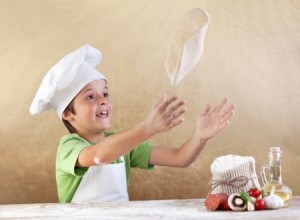 Once your children are comfortable assembling tacos, salads or other simple meals, the next step is combining ingredients to create a finished product such as pizza.
Once your children are comfortable assembling tacos, salads or other simple meals, the next step is combining ingredients to create a finished product such as pizza.
No, you don’t want your children to imitate the boy in this photo, but they can spread the dough in a pan and put on tomato sauce and toppings.
Many stores carry fresh pizza dough ready to bake. Look for one with few or no preservatives, and possibly a whole wheat crust. Once the toppings are on, most kids won’t notice the difference.
To discourage debates on toppings, have each child select one or two favorites, and make mini-pizzas so everyone gets to make his or her own round dough foundation and top it as they each choose.
As the parent, you are in charge of quality control. Pizza dough can be spread with the fingers, but keep an eye out for unintentional holes or extremely uneven surfaces. This can make one part burn before another section is done. You may also want to monitor the level of toppings, particularly the cheese.
While you want to keep an eye on the things, this is also an opportunity to let your child make a few mistakes and learn from them. Too many toppings may create a pizza that is goopier than preferred. An uneven pizza crust may not be as tasty as expected. Don’t try to make everyone’s pizza perfect; the real goal is to encourage them to have fun and appreciate the process. They can also benefit by learning from any mistakes.
Wrap up the lesson by showing them how to tell when their pizzas are properly baked. Use the light in your oven to show them how to look for bubbling in the middle and browning of the crust on the edges. Individual pizzas provide a great second phase of your cooking lessons.
